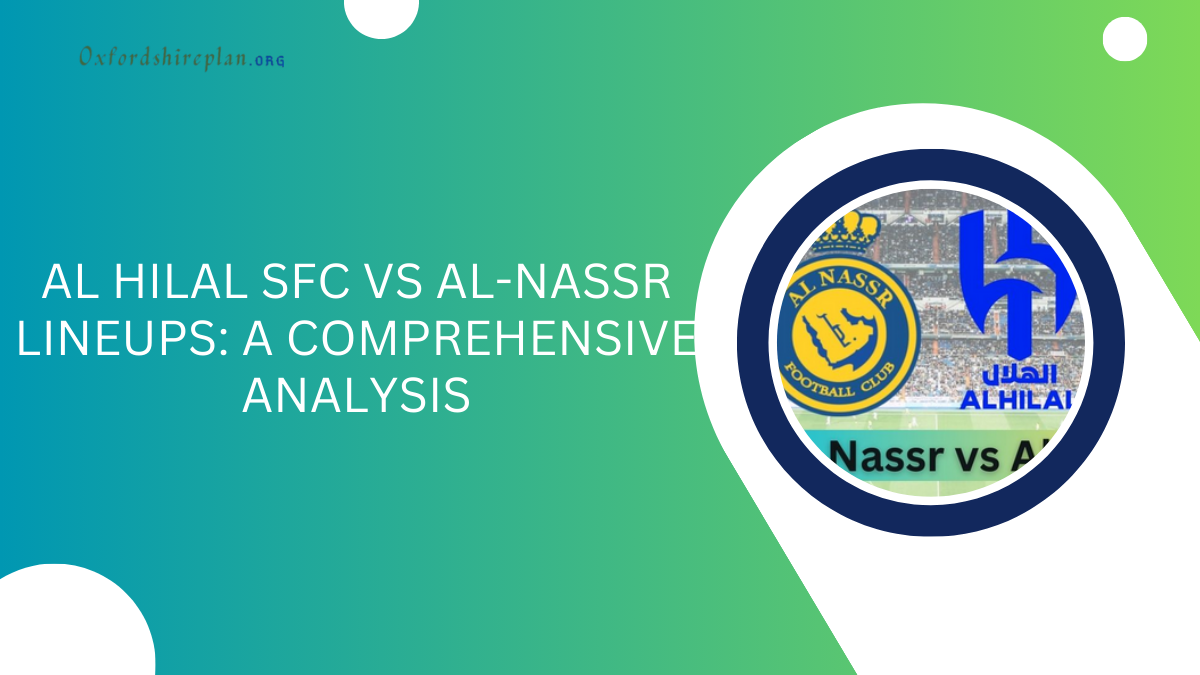When analyzing the Al Hilal Sfc vs Al-Nassr lineups, one delves into a clash that represents more than just a game; it vividly portrays a historic rivalry in Saudi Arabian football. The matchups between these two giants of Saudi football are a testament to the strategic and tactical evolution within the Saudi Pro League. Both teams boast a rich history, and their lineups are crafted to leverage their strengths and exploit their opponent’s weaknesses.

Contents
A Legacy of Excellence: Unveiling the Rivalry’s History
The rivalry between Al Hilal SFC and Al-Nassr is one of the most storied in Saudi Arabian football. Established in the early days of the Saudi Pro League, these two teams have consistently been at the forefront of the league’s success, with each match adding a new chapter to their ongoing saga. Al Hilal, founded in 1957, and Al-Nassr, founded in 1955, have both enjoyed periods of dominance, contributing to a competitive edge that has captivated fans nationwide. Al Hilal SFC has historically been a powerhouse, consistently winning domestic titles and showcasing a solid presence in Asian competitions. Their success on the field is matched by their deep fanbase and reputation for nurturing exceptional talent. On the other hand, Al-Nassr is known for its resilience and tactical prowess. Founded just a few years before Al Hilal, Al-Nassr has also enjoyed its share of domestic and continental success. Beyond Tactics: A Tale of Two Styles
Al-Hilal SFC Lineup
Formation: 4-2-3-1 / 4-1-4-1
Typical Starting XI:
- Goalkeeper: Ali Al-Habsi – The veteran goalkeeper provides experience and reliability. His shot-stopping ability and command of the penalty area are crucial.
- Right Back: Mohammed Al-Burayk—He is known for his defensive acumen and ability to join the attack, adding width and support. Center Back:** Jovane Cabral—A strong and reliable defender who excels in aerial duels and tackles.
- Center Back: Bander Al-Muwallad – Offers physicality and effective defensive organization.
- Left Back: Yahya Al-Shehri – Provides pace and crossing ability, contributing to defensive and attacking plays.
- Defensive Midfield: Omar Abdulrahman – A deep-lying playmaker with excellent vision and passing, controlling the game’s tempo.
- Central Midfield: Mohammed Kanno – Energetic and versatile, contributing both defensively and offensively.
- Central Midfield: Matheus Pereira – Offers creativity and technical skill to unlock defences and drive the play forward.
- Right Wing: Nasser Al-Dawsari – Adds pace and directness, stretching the opposition and creating goal-scoring opportunities.
- Attacking Midfield: Bafetimbi Gomis – Acts as a central attacking presence, combining physicality with technical ability to link play and finish chances.
- Left Wing: Salem Al-Dawsari—He is known for his dribbling skills and ability to cut inside from the left flank, posing a constant threat to defenders.
Tactical Approach:
Al-Hilal’s lineup typically balances maintaining possession and exploiting the wings. The 4-2-3-1 formation allows for a solid defensive base while providing flexibility in attack. Omar Abdulrahman’s role as a deep-lying playmaker is crucial for dictating play and breaking down opposition defences. The wingers, Nasser and Salem, use their pace and skill to create space and deliver quality crosses into the box for Gomis.
Al-Nassr Lineup
Formation: 4-4-2 / 4-3-3
Typical Starting XI:
- Goalkeeper: David Ospina – A seasoned goalkeeper known for his reflexes and shot-stopping capabilities.
- Right Back: Sultan Al-Ghanam – Provides defensive stability and support in attack with overlapping runs.
- Center Back: Mauro Icardi – Offers a solid defensive presence and leadership in central defence.
- Center Back: Ali Al-Bulaihi – Effective in tackles and aerial duels, a key figure in organizing the backline.
- Left Back: Yasser Al-Shahrani – Adds attacking width and solid defensive cover on the left flank.
- Central Midfield: Luis Gustavo – A defensive midfielder who shields the defence and initiates attacks from deep.
- Central Midfield: Anderson Talisca—From midfield, Anderson Talisca provides creativity and goal-scoring, linking play between defence and attack.
- Central Midfield: Abdulrahman Al-Aboud—He is known for his work rate and balance and contributes to both defensive and offensive phases.
- Right Wing: Cristiano Ronaldo – Brings unparalleled goal-scoring ability and experience, a key figure in the attack. Striker:** Vincent Aboubakar combines physicality and finishing skills, acting as a focal point in attack.
- Left Wing: Riyad Mahrez – Offers flair and technical skill, capable of creating chances and scoring goals.
Tactical Approach:
Al-Nassr’s typical formation emphasizes a solid defensive structure focusing on quick transitions. The 4-4-2 or 4-3-3 formations allow them to maintain a solid midfield while deploying their star attackers in vast areas to exploit spaces. Cristiano Ronaldo’s presence ensures the team has a prolific goal-scorer, while the wingers and midfielders support with creative play and delivery.
Memorable Encounters: Lineups Etched in Memory
The matches between Al Hilal SFC and Al-Nassr have produced some of the most memorable encounters in Saudi football. These games often feature intense tactical battles, with each team adjusting their lineups to counter the strengths of their rivals.
One notable encounter was during the 2019 Saudi Pro League season when both teams met in a high-stakes clash. Al Hilal’s lineup included key players like Bafetimbi Gomis and Carlos Eduardo, who provided the attacking impetus. On the other side, Al-Nassr fielded a lineup featuring the likes of Abderrazak Hamdallah and Gustavo, who played crucial roles in their tactical setup. The game showcased how both teams’ lineups can adapt to the high-pressure environment of a direct clash.
Another significant match was the 2020 King Cup final, where the tactical nuances were evident in how both teams approached the game. Al Hilal’s strategy focused on maintaining possession and creating opportunities through patient build-up play. Al-Nassr, however, adopted a more direct approach, utilizing the pace of their wingers and the strength of their central forwards to challenge Al Hilal’s defence. The differing strategies highlighted the importance of tactical flexibility in these high-stakes encounters.
Beyond the Pitch: A Rivalry that Impacts Saudi Football
The Al Hilal SFC vs Al-Nassr rivalry extends beyond the football pitch, influencing various aspects of Saudi football. The intense competition between the two teams drives the popularity of the Saudi Pro League, contributing to increased viewership and fan engagement. This rivalry not only attracts local fans but also garners attention from international audiences, enhancing the profile of Saudi football on a global stage.
Moreover, the rivalry impacts player transfers and team strategies. Success in these encounters can influence the perception of a team’s strength and sway player decisions regarding transfers and contract renewals. Coaches and managers often use these games as benchmarks to gauge their tactical effectiveness and adjust their approaches for future matches.
The Future of the Clash: A Rivalry Set to Continue
As Saudi football continues to evolve, the Al Hilal SFC vs Al-Nassr rivalry is set to remain a central fixture in the league. Both clubs invest heavily in their squads, attracting top talent and improving their facilities. This investment will likely enhance the quality of their lineups, making future encounters even more exciting and competitive.
The future of this rivalry will also be influenced by the broader developments in Saudi football, including the implementation of new technologies and strategies. As teams adapt to these changes, their lineups will continue to evolve, adding new dimensions to their encounters.
In summary, the Al Hilal SFC vs Al-Nassr lineups provide a fascinating insight into the tactical and strategic elements that define one of Saudi football’s most enduring rivalries. The history, tactics, and memorable moments of their encounters underscore the significance of these matchups in shaping the landscape of Saudi football. As both teams look to build on their storied pasts, the future promises even more thrilling encounters and continued competition at the highest level.

Jonathan is an avid automobile enthusiast who is passionate about all things on wheels. From the latest car models to classic vintage rides, I love exploring the automotive world’s intricate details and engineering marvels. With years of experience in test-driving, reviewing, and analyzing cars, I provide readers with comprehensive insights and honest opinions.















